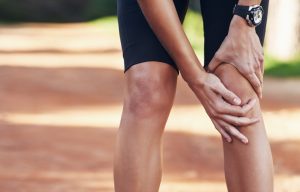Anterior Cruciate Ligament (ACL) Tears

The anatomy ACL tears
The knee joint is comprised of three bones: femur, tibia, and patella (kneecap). Knee stability is provided by 4 primary ligaments.
The collateral ligaments are located on the sides of the knee. The medial collateral ligament (MCL) is found on the inside aspect of the knee and the lateral collateral ligament (LCL) on the outside aspect of the knee. These collateral ligaments provide side-to-side stability in the knee and can be injured with or without an ACL tear.
The cruciate ligaments are located inside the knee joint. They connect the femur to the tibia in the very center of the knee. The ACL prevents forward translation of the tibia on the femur. The posterior cruciate ligament (PCL) prevents backward translation of the tibia on the femur. Because of their diagonal trajectories, both the ACL and PCL contribute to rotational stability, too.
What causes ACL tears?
Most ACL tears occur as a result of a non-contact, pivoting injury. This is seen when patients:
- Change directions rapidly
- Land awkwardly from a jump
- Stopping suddenly while running, skiing, etc
- Direct trauma
What are the symptoms of ACL tears?
Many people will describe sudden pain and perhaps hearing a “pop” as the knee gives way. This is accompanied by swelling and sometimes an inability to “trust” your knee. In isolated ACL injuries, the pain typically subsides within a day or two.
Symptoms in the subsequent days may include decreased range of motion, further episodes of instability, and pain along the joint lines.
Treating ACL tears
Most ACL injuries can be diagnosed with a combination of patient history and physical exam. Various imaging studies are used to confirm the diagnosis.
- X-ray: X-rays are an excellent screening tool to help rule out other injury
- MRI: an MRI is obtained to confirm the diagnosis and to evaluate for other injury, such as a meniscal tear or cartilage injury
Treatment for an ACL tear is dictated by a patient’s age and lifestyle demands. Because most patients that tear their ACL are active, most patients will undergo surgery in order to return to that lifestyle.
- Non-surgical treatment: A torn ACL will not heal without surgery. Nonetheless, some less active patients may be asymptomatic and not bothered by a sense of knee instability. Although rare, these patients may be effectively treated with appropriate bracing and physical therapy.
- Surgical treatment: the goal of ACL surgery is to restore stability to the knee. Most ACL ruptures are not amenable to repair and must be reconstructed with other tissue.
- Graft options: In young patients, I recommend autograft, which is your own tissue. Graft options in that case include bone-patella-bone, hamstring tendon, or quadriceps tendon. Cadaver graft (allograft) can be used in the appropriate patient. We will discuss the advantages and disadvantages of each graft option
- Procedure: the surgery is performed arthroscopically. There will be 2 small incisions at the bottom of your patella and a small incision on your tibia for graft harvest.
Physical therapy
Physical therapy is absolutely critical in restoring normal motion and strength to your knee and lower extremity. Physical therapy will typically begin the same week as your surgery.
Our physical therapy protocol offers a stepwise return to activity and sport. For most patients, 9-12 months is required to return to cutting and pivoting sports, such as football, basketball, soccer, lacrosse, etc.
If you think you have suffered from an ACL tear, book an appointment today with Dr. David Dare. Dr. Dare is a fellowship-trained orthopedic surgeon specializing in sports medicine and shoulder surgery. His primary goal is to develop an effective treatment plan using the least invasive techniques to relieve your shoulder pain, restore function, and get you back to feeling your best. Call 919.781.5600 or fill out a form on this page.


